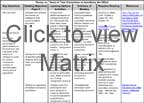Key Questions
- Why do special populations of gifted students need special considerations for programming and curricular options?
- How can programming for gifted students incorporate diverse ethnic perspectives?
- Why do linguistic minority gifted students
need special considerations for programming? - What modi fications to the curriculum should be made for linguistic minority gifted students?

Demographics in the nation and Florida have changed drastically over the last fifty years. We are becoming a much more diverse society. School populations are reflective of the diversity within the broader population. The same diversity that is seen in the general school population should be reflected in any special educational program. Yet, because of a lack of federal mandates entitling gifted students to programs funded to provide for their diverse needs, wide discrepancies exist in the definition, identification, availability, and types of services provided to them.
The Jacob Javits Gifted and Talented Students Education Act (Javits) was originally passed by Congress in 1988 as part of the Elementary and Secondary Education Act to support the development of talent in U.S. schools. The Javits Act, which is the only federal program dedicated specifically to gifted and talented students, does not fund local gifted education programs. The purpose of the Act is to orchestrate a coordinated program of scientifically based research, demonstration projects, innovative strategies, and similar activities that build and enhance the ability of schools to meet the special educational needs of gifted and talented students. The Javits Act focuses resources on identifying and serving students who are traditionally underrepresented in gifted and talented programs, particularly economically disadvantaged, English Language Learners (ELL), and disabled students, to help reduce gaps in achievement and to encourage the establishment of equal educational opportunities for all students.
In 2007, The National Association for Gifted Children (NAGC) and The Association for Gifted (TAG) collaborated in developing Teacher Preparation Standards which place a major focus on development of the gifts and talents of the still underrepresented and underserved diverse populations of gifted students. These standards are intended to move the field forward toward more inclusionary practices and a new level of understanding that affects the teachers responsible for ensuring that potentially gifted students from low socioeconomic status (SES) and English Language Learners (ELL) backgrounds are referred for testing and provided with appropriate services. While reviewing these standards,![]() which former students come to mind that you may have missed?
which former students come to mind that you may have missed?
Giftedness exists in every segment of our nation’s school population. Yet, several groups remain unidentified or underrepresented in our current gifted programs. The same is true in Florida.
We’ve seen how national definitions focus on educational opportunity for gifted have changed over time. Similarly, Florida’s definition of gifted has evolved in response to the changing demographics of the state’s school population. Florida Administrative Code 6A-6.03019 defines and establishes criteria for the identification of the state’s gifted population. The current definition identifies those with superior intellectual development who are capable of high performance. The criteria established for their identification also emphasizes the need to broaden our search for gifted students to include economically disadvantaged families and/or English Language Learners. Click here to download the Demographics of Gifted Students In Florida. The data makes it clear why these two particular groups have been targeted.
to download the Demographics of Gifted Students In Florida. The data makes it clear why these two particular groups have been targeted.
